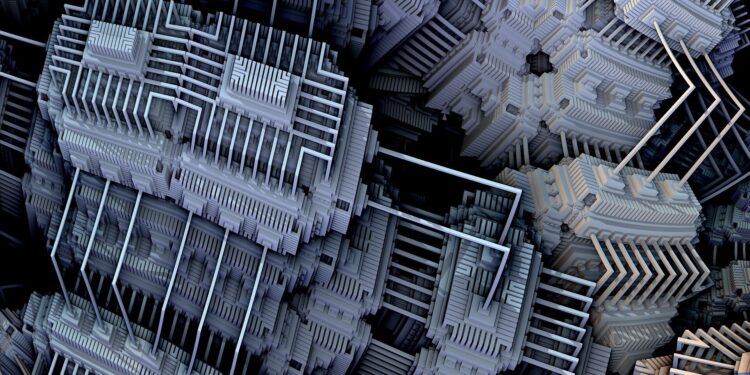Credit: Pixabay/CC0 Public domain
A new fusion of materials, each with particular electrical properties, has all the components required for a unique type of superconductivity that could provide the basis for more robust quantum computing. The new combination of materials, created by a team led by Penn State researchers, could also provide a platform for exploring physical behaviors similar to those of mysterious theoretical particles known as chiral Majoranas, which could be a another promising component for quantum computing.
The new study appears in the journal Science. The work describes how the researchers combined the two magnetic materials in what they called a critical step toward realizing emerging interfacial superconductivity, which they are currently working toward.
Superconductors (materials without electrical resistance) are widely used in digital circuits, powerful magnets in magnetic resonance imaging (MRI) and particle accelerators, and in other technologies where maximizing the flow of electricity is crucial.
When superconductors are combined with materials called magnetic topological insulators (thin films only a few atoms thick that have been made magnetic and restrict the movement of electrons at their edges), the new electrical properties of each component work together to produce “chiral topological superconductors”.
Topology, or the specialized geometries and symmetries of matter, generates unique electrical phenomena in the superconductor, which could facilitate the construction of topological quantum computers.
Quantum computers have the potential to perform complex calculations in a fraction of the time it takes traditional computers because, unlike traditional computers which store data as ones or zeros, the quantum bits in quantum computers store data simultaneously in a range of possible states.
Topological quantum computers further improve quantum computing by taking advantage of the way electrical properties are organized to make computers robust to decoherence, or the loss of information that occurs when a quantum system is not perfectly insulated.
“Creating chiral topological superconductors is an important step toward topological quantum computing that could be extended to wide use,” said Cui-Zu Chang, Henry W. Knerr Early Career Professor and associate professor of physics at Penn State. and co-corresponding author of the paper.
“Chiral topological superconductivity requires three ingredients: superconductivity, ferromagnetism, and a property called topological order. In this study, we produced a system with all three properties.”
The researchers used a technique called molecular beam epitaxy to stack a topological insulator made magnetic and an iron chalcogenide (FeTe), a transition metal that shows promise for harnessing superconductivity. Topological insulator is a ferromagnet, a type of magnet whose electrons rotate in the same way, while FeTe is an antiferromagnet, whose electrons rotate in alternating directions.
The researchers used various imaging techniques and other methods to characterize the structure and electrical properties of the resulting combined material and confirmed the presence of all three critical components of chiral topological superconductivity at the interface between the materials.
Previous work in this area has focused on the combination of superconductors and non-magnetic topological insulators. According to the researchers, adding the ferromagnet was particularly difficult.
“Normally, superconductivity and ferromagnetism compete, so it is rare to find robust superconductivity in a ferromagnetic material system,” said Chao-Xing Liu, professor of physics at Penn State and co-corresponding author of the paper. article.
“But the superconductivity of this system is actually very resistant to ferromagnetism. It would take a very strong magnetic field to suppress the superconductivity.”
The research team is still investigating why superconductivity and ferromagnetism coexist in this system.
“It’s actually quite interesting because we have two non-superconducting magnetic materials, but we put them together and the interface between these two compounds produces very robust superconductivity,” Chang said.
“Iron chalcogenide is antiferromagnetic, and we predict that its antiferromagnetic property will be weakened around the interface to give rise to the emerging superconductivity, but we need more experiments and theoretical work to verify whether this is true and clarify the superconducting mechanism.”
The researchers said they believe this system will be useful in the search for material systems exhibiting behaviors similar to those of Majorana particles, theoretical subatomic particles first emitted in 1937. Majorana particles act as their own antiparticle, a unique property that could potentially allow them to be used as quantum bits in quantum computers.
“Providing experimental evidence for the existence of the chiral Majorana will be a crucial step in creating a topological quantum computer,” Chang said. “Our field has had a checkered past trying to find these elusive particles, but we believe this is a promising platform for exploring Majorana physics.”
More information:
Hemian Yi et al, Interface-induced superconductivity in magnetic topological insulators, Science (2024). DOI: 10.1126/science.adk1270. www.science.org/doi/10.1126/science.adk1270
Provided by Pennsylvania State University
Quote: Combination of materials can support unique superconductivity for quantum computing (February 8, 2024) retrieved February 8, 2024 from
This document is subject to copyright. Apart from fair use for private study or research purposes, no part may be reproduced without written permission. The content is provided for information only.



